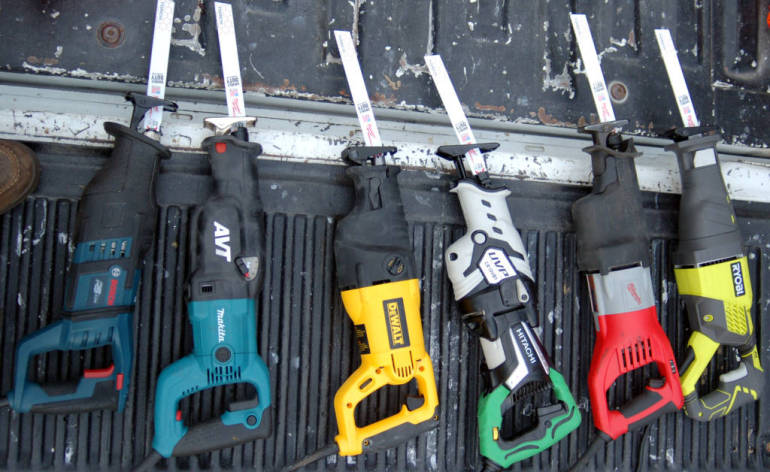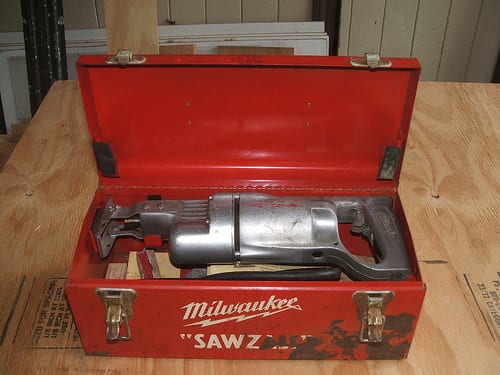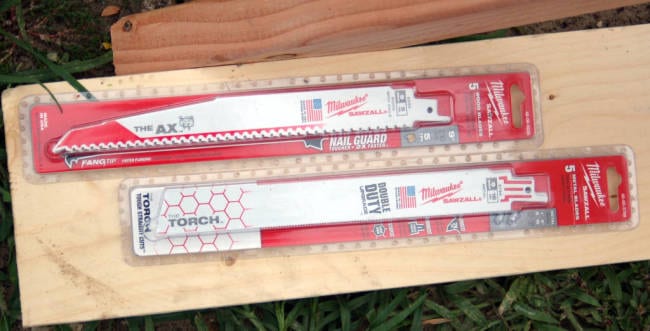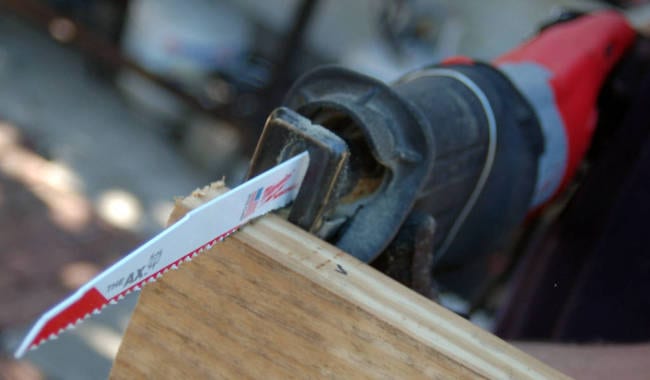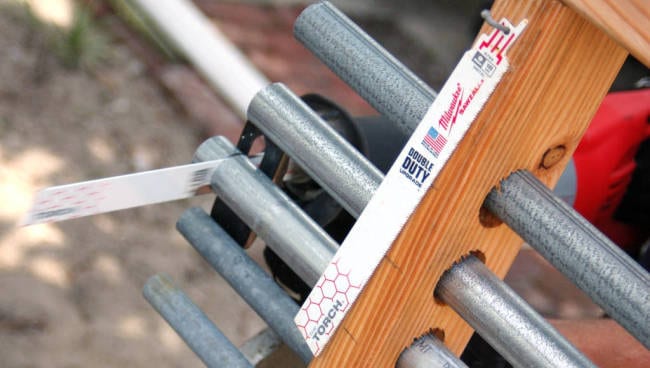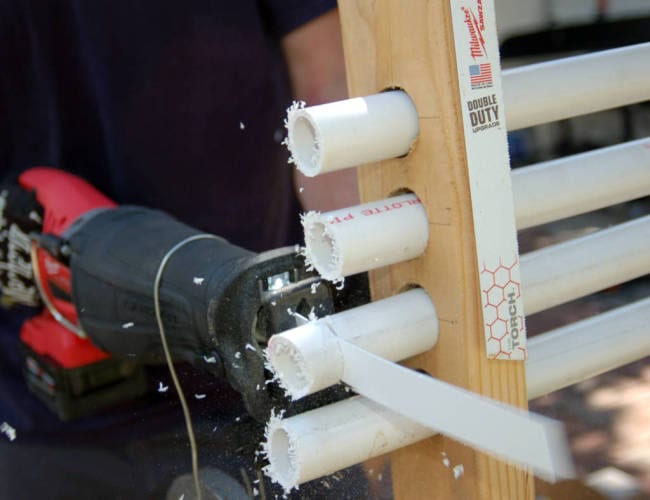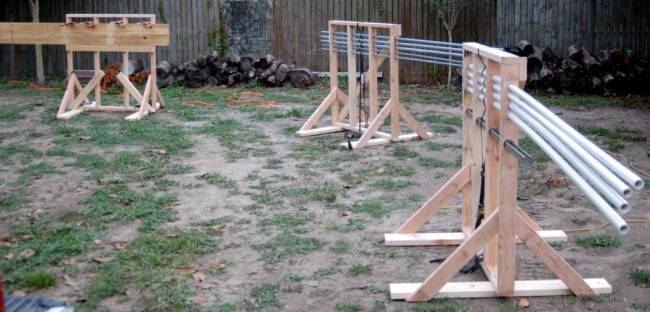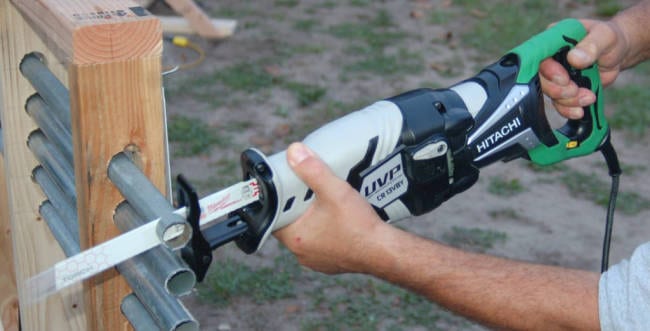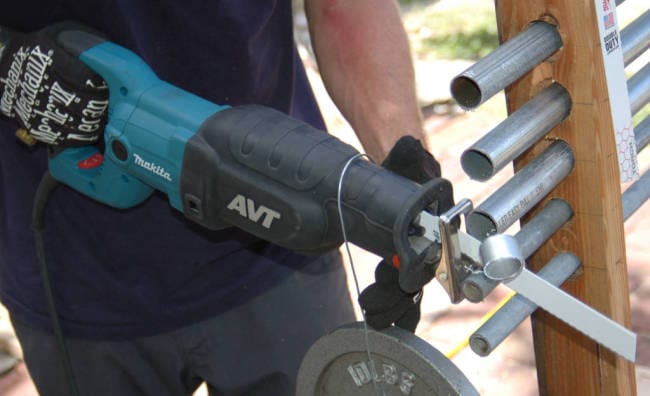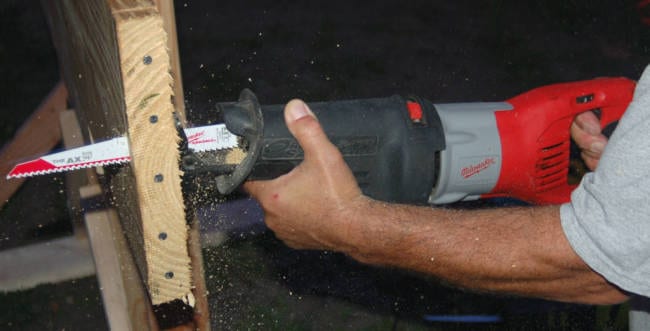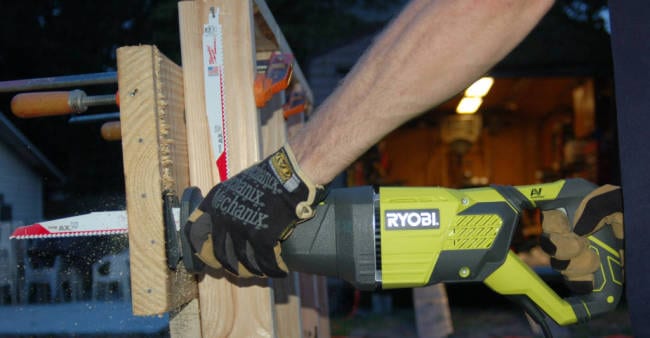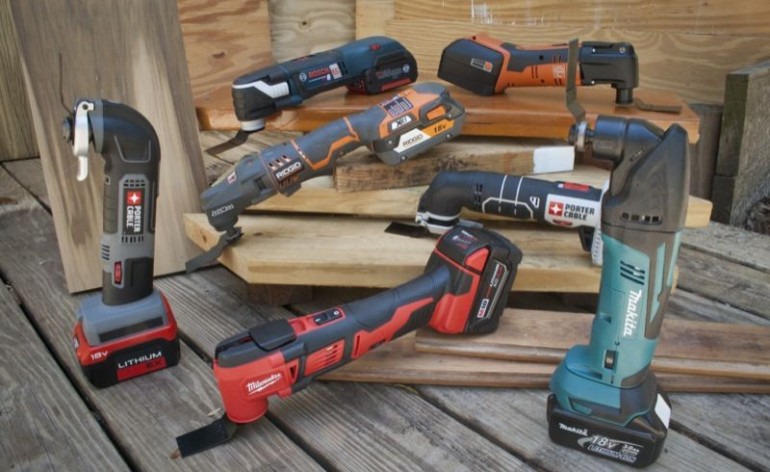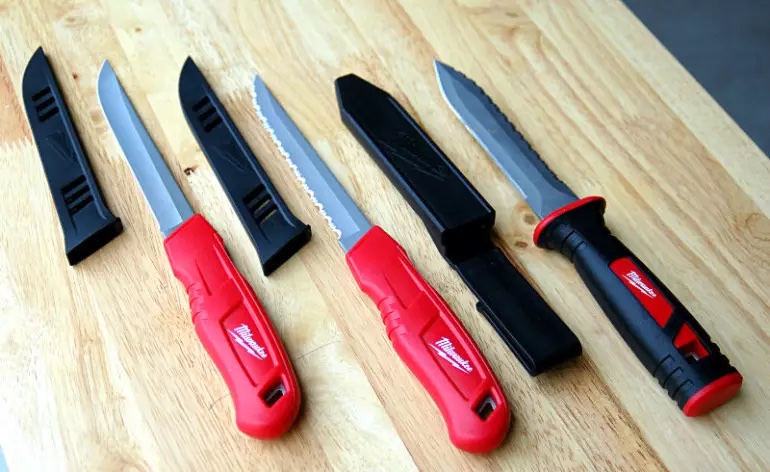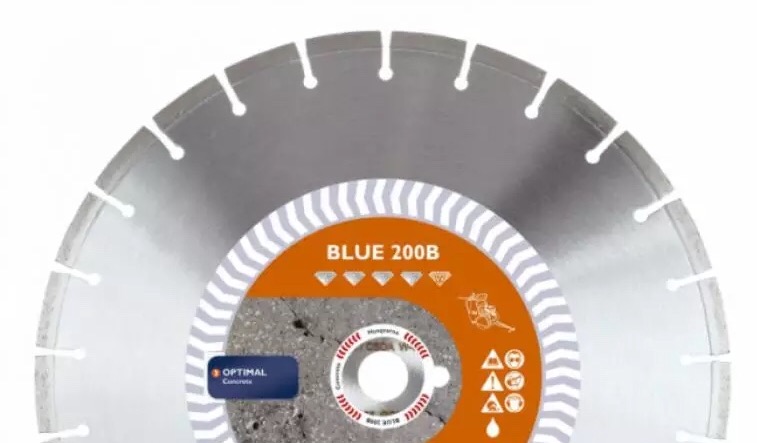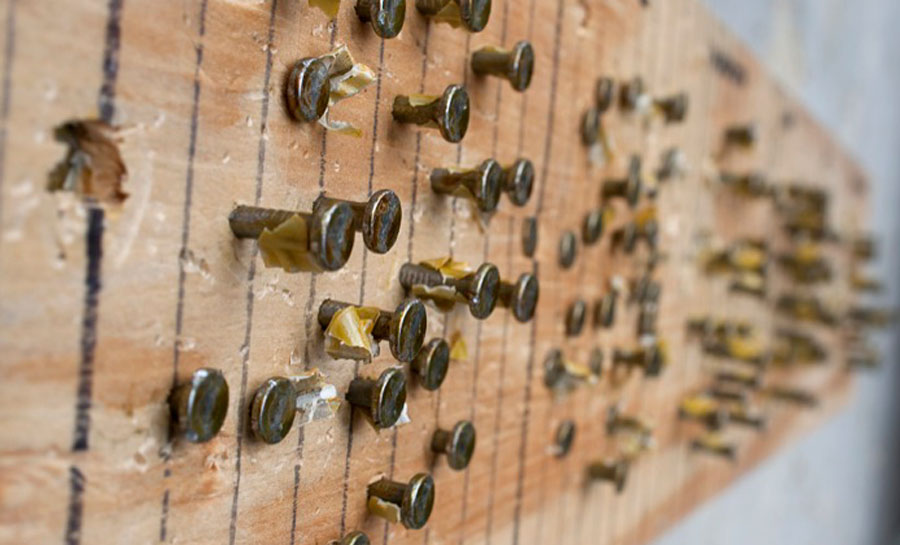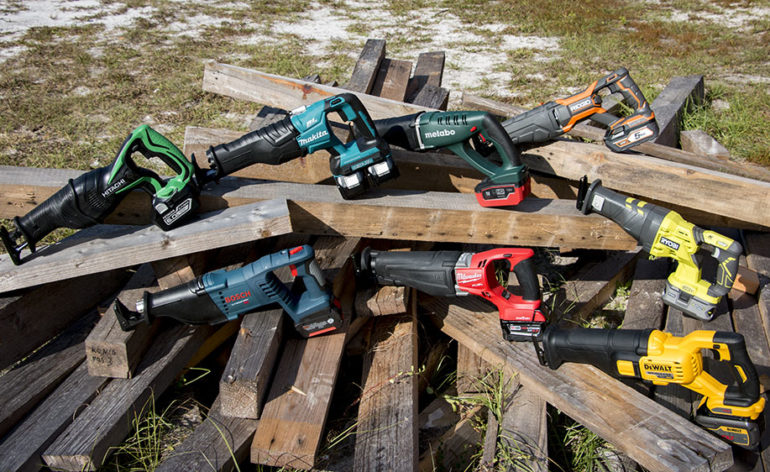We put some of the top heavy duty corded reciprocating saws on the market head to head to see who can make the claim to be at the top of the pile. We took recip saws from Bosch, DeWalt, Hitachi, Makita, Milwaukee, and Ryobi through a series of three tests to see how fast they cut, how packed they are with features, and how user-friendly they are.
Reciprocating Saw History
Reciprocating saws are demolition tools by nature. First designed by Milwaukee Tool in 1951 under the name “Sawzall”, these tools were designed to cut through a variety of materials including wood, PVC, and a variety of metals. In its most basic form, the reciprocating saw is very simple. The motor drives the shaft back and forth which moves the replaceable blade in a sawing motion. Blades were developed to cut through wood, nail embedded wood, metal, and general purpose uses.
As time passed, technology improved, and we began to see more options available on reciprocating saws. Variable speed settings showed up that allow users to dial in and achieve more efficient cutting based on the material they were working with. One of the biggest innovations was the addition of orbital action.
Orbital action lifts the blade in one direction as it cuts and then drives it down against the material, allowing for more aggressive cutting. When viewing orbital action from the side, you can see the blade moving in an elliptical pattern. This is best applied when cutting wood as it can create additional vibration when cutting through metals and other rigid materials.
In more recent years, a lot of effort has gone into the ergonomics of reciprocating saws. The rough demolition style cutting that recip saws are used for creates a lot of vibration that can wear out a user’s arm in a hurry.
Most companies now employ varying types of anti-vibration technologies. These range from shock absorbing handles to internal counterweight designs. One company even makes a counteraction blade system.
Choosing Blades for Your Reciprocating Saw
One of the great things about most reciprocating saws is that the clamp fitting for the blade is the same from manufacturer to manufacturer, so you can choose the blade you prefer. That also presents an issue for the uninitiated since there are a lot of blades to choose from. We chose Milwaukee’s Ax and Double Duty Torch Sawzall Blades for our testing.
Several thoughts went into deciding on Milwaukee Sawzall blades for our test. Two in particular stood out to me. First, Milwaukee is constantly innovating within their company. “Disruptive Innovation” is part of their corporate culture, and it’s nearly impossible to talk to someone at Milwaukee without hearing that term. With respect to these blades, disruptive innovation comes in the design of the teeth (on the “Ax”) which reject getting caught on nails—making them perfect for our nail-embedded wood test). Secondly, Milwaukee invented the reciprocating saw. When you’re the one to design anything from the beginning, you are intimately knowledgeable about it. We counted on this combination of innovation and knowledge to yield a reliable and consistent blade for our testing … and we weren’t disappointed.
For wood or nail embedded wood applications, blades like The Ax from Milwaukee are what you’re looking for. This blade has 5 TPI (teeth per inch) and is available in 6 or 12 inch lengths. Blades that have fewer teeth per inch result in rougher but faster cuts for soft yet dense materials like wood. You’ll choose your length simply based on how long you need the blade to be for the material you’re cutting.
For cutting metal, you can’t go wrong with a blade like Milwaukee’s Double Duty Torch. You want more teeth per inch (TPI), such as the 18 TPI blade we used or the 24 TPI version, which is also available at about the same price. While cutting is slower with a greater number of teeth, it allows for much greater control and a smoother finished edge.
There are also times when you need to cut material like PVC. A blade design similar to what we used on metal is the most efficient. The difference is that you can grab a blade that has fewer teeth per inch for a balance of fast rough cutting and controlled cutting through the material. We used the Milwaukee Double Duty Torch again, but this time their 14 TPI design. It also comes in a 10 TPI configuration which would also work well in this application.
Testing Methods
We put each reciprocating saw through a series of three tests to simulate the conditions a user would likely experience using this tool. To control the amount of downward force on each trial, a 10 pound weight was hung around the neck of the saw, and I used my hands only to guide the saw and catch it at the end of the cut. The tests were run a total of three successful time for each saw. Failed tests were thrown out and not used in our data. The rigs that we built for the testing were each secured to eliminate any significant movement of the material during testing.
The first test was nail embedded wood. We used 2 x 12 pressure treated lumber that we hammered 5 galvanized nails directly into. Each saw had to make a cross cut downward through the board. Second was a PVC test. This was simply four 1″ PVC pipes arranged vertically in our test rig. The third test sent our recip saws through five galvanized pipes of varying diameters, again arranged vertically.
To get an idea of the ergonomics and vibration of each saw, I also cut through each of the materials without the weight using a traditional two handed grip.
Results of Testing
Nail Embedded Wood
| Nail Embedded Wood Test |
Trial 1 (seconds) | Trial 2 (seconds) | Trial 3 (seconds) |
| Bosch | 9.84 | 9.81 | 9.73 |
| DeWalt | 13.82 | 12.96 | 13.02 |
| Hitachi | 12.31 | 12.08 | 11.88 |
| Makita | 8.05 | 8.57 | 8.51 |
| Milwaukee | 8.40 | 7.80 | 7.70 |
| Ryobi | 13.33 | 12.37 | 12.78 |
For nail embedded wood, we looked at the fastest time for each reciprocating saw. At 7.70 seconds, Milwaukee was the fastest but Makita was only 0.35 seconds behind. Bosch rounded out the sub-10 second group, followed by Hitachi, Ryobi, and DeWalt in that order.
- Nail Embedded Wood Speed Winner: Milwaukee Super Sawzall
PVC
| PVC Test | Trial 1 (seconds) | Trial 2 (seconds) | Trial 3 (seconds) |
| Bosch | 7.91 | 7.80 | 7.81 |
| DeWalt | 9.85 | 8.96 | 9.52 |
| Hitachi | 8.73 | 9.69 | 8.38 |
| Makita | 7.32 | 7.28 | 8.04 |
| Milwaukee | 6.90 | 7.33 | 6.97 |
| Ryobi | 10.04 | 9.07 | 8.70 |
Cutting through four 1″ PVC pipes doesn’t take long with the right blade, and this test was fast. Milwaukee was the only saw able to break the 7 second mark, and it did it twice. Again, Makita was right behind with a fastest cut of 7.28 seconds. Bosch was slightly slower, though this test showed that the reduced speed may be due to the soft start motor. Bosch cut really smoothly through the material thanks to that feature. Hitachi came in 4th, followed by Ryobi and DeWalt (meaning that the general speed/performance order was the same as with our wood cutting tests).
- PVC Test Speed Winner: Milwaukee Super Sawzall
Galvanized Pipe
| Galvanized Pipe Test |
Trial 1 (seconds) | Trial 2 (seconds) | Trial 3 (seconds) |
| Bosch | 18.41 | 17.42 | 17.36 |
| DeWalt | 22.03 | 18.64 | 21.53 |
| Hitachi | 19.28 | 21.54 | 21.67 |
| Makita | 16.65 | 16.27 | 16.86 |
| Milwaukee | 14.40 | 14.17 | 14.68 |
| Ryobi | 19.04 | 19.99 | 19.32 |
Things slow down when you start cutting through metal, and this test also brought out the issue of vibration more than the others. The Milwaukee Super Sawzall blew away the competition here with the Makita only able to get within 2.20 seconds of its 14.17 second winning cut. With the results finally in, Milwaukee swept all three speed tests with Makita taking runner up in all three. Bosch took third again and set the border between low and high vibration in this test.
DeWalt finally got out of the cellar on this test with an 18.64 second effort and Hitachi narrowly edged out the Ryobi reciprocating saw. When you look at the results of all three tests, you see a significant difference in how much the numbers vary between the top three and bottom three from trial 1 to trial 3. The saws with better vibration control had much better consistency than the ones with less or none. In fact, had we not been able to get one smooth (ish) trial out of DeWalt, it would have been at the bottom again. It’s a similar story for Hitachi. The surprise is that, while not the fastest saw, Ryobi was very consistent in its cutting, showing that the vibration control in this value-priced saw is actually pretty good!
Galvanized Pipe Speed Winner: Milwaukee Super Sawzall
Tool-by-Tool: Each Reciprocating Saw in Detail
Bosch RS428 1-1/8″ Vibration Control Reciprocating Saw
- Power: 14 amps
- Stroke Length: 1-1/8″
- Speed: 0 — 2900 strokes per minute
- Weight: 8 pounds
- Vibration Reduction: Vibration Control System
- Trigger Lock: yes
- Orbital Action: yes
- Retail Store Price: $159
- Amazon Price: $159
Bosch’s Vibration Control Reciprocating Saw has is a constant orbit design that leads me to believe it is mainly designed for wood and demo use. Normally, you’ll want the option to shut that off when cutting metal. The shoe adjust is tool-free and easy to use, but the button to release the shoe is a bit of an issue. It’s underneath the saw right where your fingers will be placed on the front grip. While it didn’t happen while I was using it, you could accidentally release the shoe during use.
The vibration control is effective, and I really like the more compact design and feel of this recip saw. The trigger is designed for two finger use, but the handle is large enough, and the trigger spring at such a tension, that those preferring one finger on the trigger will still be happy. There is some design brilliance where the shaft and housing meet. The shaft and blade clamp are fully exposed so that debris build up is greatly reduced. The blade clamp design was also the easiest to use of the six saws we tested. With plenty of texture on the metal and slightly bulged from being circular, this was a huge plus.
There is also the fact that Bosch’s saw comes in a soft bag rather than a hard case. I personally prefer the versatility that comes with a bag. It’s easier to carry extra blades or even additional tools without forcing things into a defined space. While some may disagree, this is a win in my book.
Bosch came in third place for each of the tests in our speed test. Part of this is due to its soft start feature. For many users, sacrificing a little bit of time for the initial control that the soft start offers will be a major plus. It’s also about $45 less expensive than Milwaukee and Makita, making it a very solid balance of performance and value.
- Pros: Exposed shaft, compact design, trigger, vibration control, tool bag for storage
- Cons: Shoe adjust release button, orbiting mode only
Ranking: 3rd out of 6
Award: Easiest Blade Change
DeWalt DW311 13.0 Amp Reciprocating Saw Kit
- Power: 13 amps
- Stroke Length: 1-1/8″
- Speed: 0 — 2700 strokes per minute
- Weight: 9.0 pounds
- Vibration Reduction: none
- Trigger Lock: no
- Orbital Action: yes
- Retail Store Price: $159
- Amazon Price: $154.99
DeWalt’s Reciprocating saw is the only one of the group that doesn’t have a defined anti-vibration technology … and it shows. This saw had the most vibration of the six we tested. Although the blade changes are tool free, it is a challenge. This is one of several saws that requires the shaft to be out from the housing enough to actually get to the clamp. There is also very little grip available with which to twist the blade clamp, making it even tougher when wearing gloves. This is a one finger trigger design, and the spring requires a bit too much force for my liking. You’ll notice fatigue in your trigger finger if you use this saw a lot.
The shoe adjustment is a positive on this design. It’s simple and easy to use. The speed is adjustable, and you can switch between orbital and non-orbital modes. Like the Bosch, I appreciate DeWalt’s compact design. I also really like the case. DeWalt kept it compact to match the saw, and the cord wraps in well without pinching it in a way that is likely to cause issues.
DeWalt’s lack of vibration control really hurt it in the speed tests. It came out consistently slow for a saw that is priced near what Bosch offers. For occasional users and DeWalt fans, this will still get the job done, but for people using a recip saw frequently, you may want to look at other options.
- Pros: Shoe adjustment, compact design, orbital and non-orbital modes, case design, variable speed control
- Cons: Vibration, challenging blade changes, trigger spring tension
Ranking: 5th out of 6
Awards: Best Case Design
Hitachi CR13VBY 12 Amp Low Vibration Reciprocating Saw
- Power: 12 amp
- Stroke Length: 1-1/4″
- Speed: 0 — 3000 strokes per minute
- Weight: 9.7 pounds
- Vibration Reduction: User Vibration Protection
- Trigger Lock: no
- Orbital Action: Swing mode (supposed to produce less rebounding than traditional orbital action)
- Retail Store Price: $144
- Amazon Price: $144
The Hitachi Low Vibration Reciprocating Saw is one of the heavier designs we tested. Although the blade changes are tool free, it is a challenge to make them, and the blade fits loosely in the clamp. The ergonomics of the saw are just … weird. There’s nothing I can really point to specifically, but it didn’t feel like it fit well in my hands. It looks and feels like there is a lot of cheap plastic in the design. The storage case also tends to pinch the cord in a way that’s likely to create an issue over time.
Hitachi does give you variable speed controls and the ability to switch in and out of orbital mode. The 12 amp motor is adequate to keep up with the job. This is the only saw we noticed that provided access to replace the motor brushes.
Hitachi’s vibration control wasn’t the most effective, and it suffered from vibration issues in our testing. By solidifying the feel and improving the vibration control of this saw, it could be poised to be an excellent midrange option in the next generation.
- Pros: Orbital and non-orbital modes, variable speed control
- Cons: Loose fitting blade, heavier design, cheaper feel, tighter case design
Ranking: 6th out of 6
Makita JR3070CT AVT Recipro Saw — 15 Amp
- Power: 15 amps
- Stroke Length: 1-1/4″
- Speed: 0 — 2800 strokes per minute
- Weight: 10 pounds
- Vibration Reduction: Anti-Vibration Technology
- Trigger Lock: yes
- Orbital Action: yes, 4 position
- Retail Store Price: $199
- Amazon Price: $199
Makita’s AVT Recipro Saw made a strong case for the top spot. The only negative was the blade change, and it’s really more like half a negative. This is another saw that requires the shaft to be out further to get your fingers around the blade clamp … but only to get the blade out. Without a blade, the clamp is in the open position and locks closed when a blade is installed. That means you can simply push the blade in no matter what position the shaft is in, with a gloved hand, of course.
You get multiple orbital settings on Makita’s reciprocating saw to adjust the level of aggressiveness to your preference. The Anti-Vibration Technology works really well, so it is more comfortable to use than most models. The shoe adjustment is also easy, and you get a solid “click” to let you know it’s in place. The two finger trigger has the spring tension set and a large enough handle to use with one finger if you like. You’ll also appreciate the multiple speed settings. When cutting on the wood test, the AVT Recipro Saw felt like a beast as it chewed through the material!
Makita’s runner-up status in speed is not something they should feel bad about. This is a top of the line recip saw that performs and feels like one! The excellent performance and combination of features will make it a top choice for many professionals.
- Pros: Multiple orbital settings, variable speed settings, shoe adjustment, trigger, solid feel/ergonomics, great vibration control
- Cons: Shaft needs to be out for blade removal
Ranking: 2nd out of 6
Awards: Overall Runner Up, Best Combination of Features and Design, Lowest Vibration (tied with Milwaukee)
Milwaukee 6538-21 15.0 Amp Super Sawzall Recip Saw
- Power: 15 amps
- Stroke Length: 1-1/4″
- Speed: 0 — 2800 strokes per minute
- Weight: 9.8 pounds
- Vibration Reduction: Counter Balance Mechanism
- Trigger Lock: no
- Orbital Action: yes, adjustable
- Retail Store Price: $199
- Amazon Price: $188.35
I’ve only got one complaint about the Milwaukee Super Sawzall: The blade changes. While the change itself is easy, this is another saw that requires the shaft to be further out to access it.
The Super Sawzall has a two finger trigger that can easily be used with one if you prefer. This has the easiest adjustment position for the multiple orbital modes on top of the handle. The shoe adjustment is also very simple and very easy to use. Multiple speed settings allow you to dial in the speed you need. When cutting, the Super SawZall feels fast and efficient, which our data backs up. It also feels like the cutting action lends itself to less vibration, making me want to take apart the saw and see how they did it. Milwaukee also did a very nice job with their hard case design on this one.
Sweeping our speed tests, excellent design, great features, and tying with Makita for vibration control, Milwaukee is the clear winner of our shootout. The Milwaukee Super Sawzall proves once again that the inventor of the reciprocating saw class of tools is still the master that others are still trying to learn from.
- Pros: Trigger, multiple orbital modes, orbital adjustment slider position, shoe adjustment, variable speed control, fast cutting, great vibration control, case design
- Cons: Shaft needs to be out for blade removal
Ranking: 1st out of 6
Awards: Overall Winner, Best Vibration Control (tied with Makita), Fastest Cutting
Ryobi RJ185V Variable Speed Reciprocating Saw
- Power: 10 amps
- Stroke Length: 1-1/8″
- Speed: 0 — 3000 strokes per minute
- Weight: 7.3 pounds
- Vibration Reduction: Anti-Vibe Technology
- Trigger Lock: no
- Orbital Action: no
- Retail Store Price: $65
- Amazon Price: not available
Ryobi’s Variable Speed Reciprocating Saw was the least expensive of the saws we tested. As you would imagine, this comes at the expense of some features. You won’t get an orbital action with this saw, nor multiple speed settings. The shoe adjustment requires the use of an Allen wrench.
Even though you don’t get multiple fixed speed settings, the two finger trigger is still variable speed, so you do have some control over the speed of your cut. The blade clamp design is simple and really effective. While Bosch had the easiest blade changes, Ryobi was right behind them. The RJ185V isn’t just the least expensive saw, it’s the least expensive by a lot! This easily gives Ryobi the Best Value Award in our shootout considering it still has respectable performance. For the homeowner or tradesman looking for an occasional use reciprocating saw, the Ryobi RJ185V is a no brainer.
Consistent performance and its vibration control system makes Ryobi a surprising conversation topic among the heavy duty recip saw class. With value pricing nearly $80 less than the Hitachi, we expect he Ryobi RJ185V is going to find its way into a lot of tool arsenals.
- Pros: Low price, trigger, blade clamp design,
- Cons: No orbital action, no tool free shoe adjustment, loose overmold on front
Ranking: 4th out of 6
Award: Best Value
—Reprinted with permission from ProToolReviews.com; written by Thomas Gaige, one of the original founders of Pro Tool Reviews. Tom has nearly twenty years of experience in residential and commercial construction, having been a project manager at an engineering firm, then starting his own architectural design company, and finally owning and operating a residential construction company as a licensed contractor in South Carolina. Tom's specialties are problem-solving and attention to detail—two traits which are apparent each time he tests and reviews power tools.
